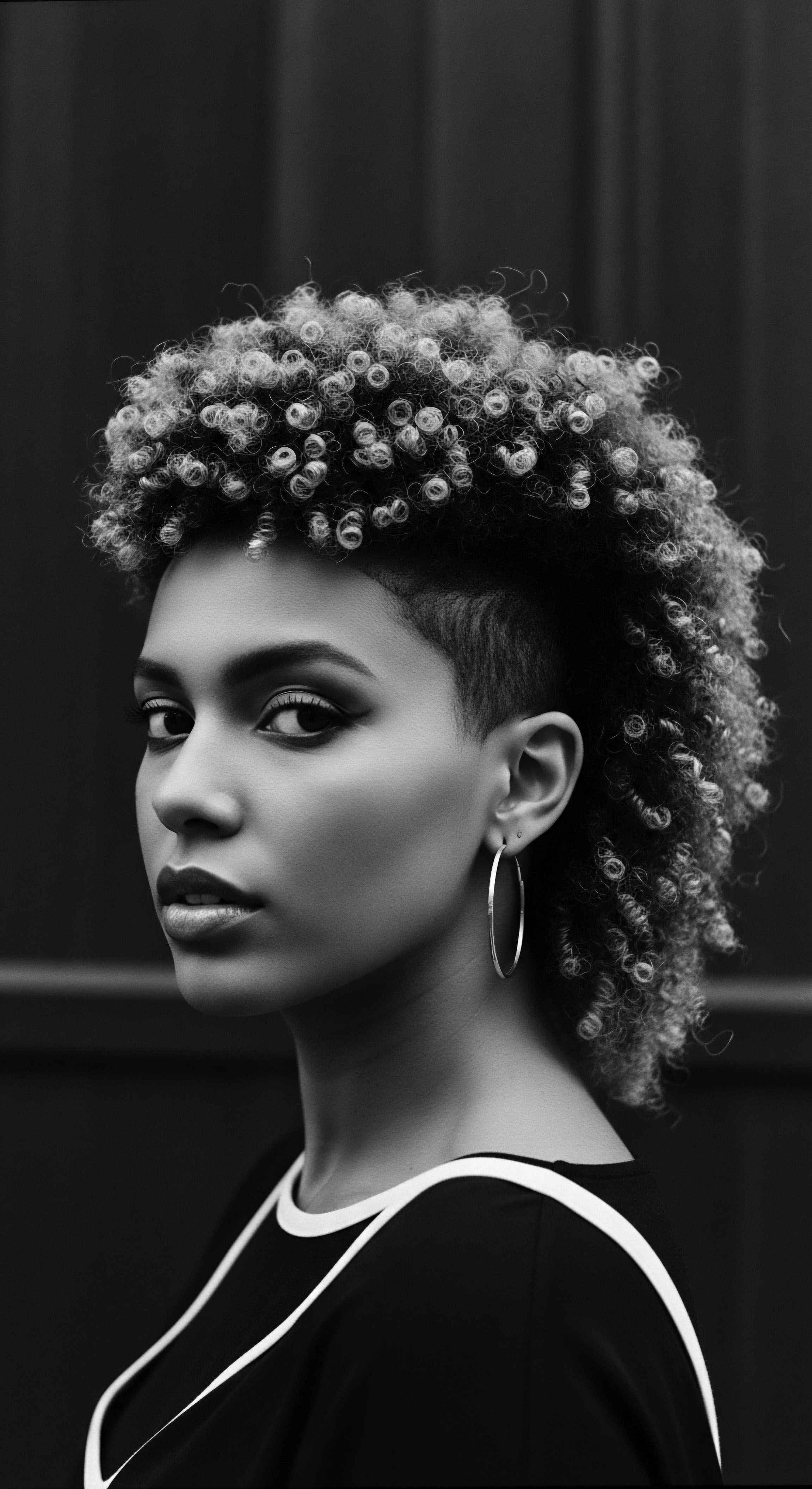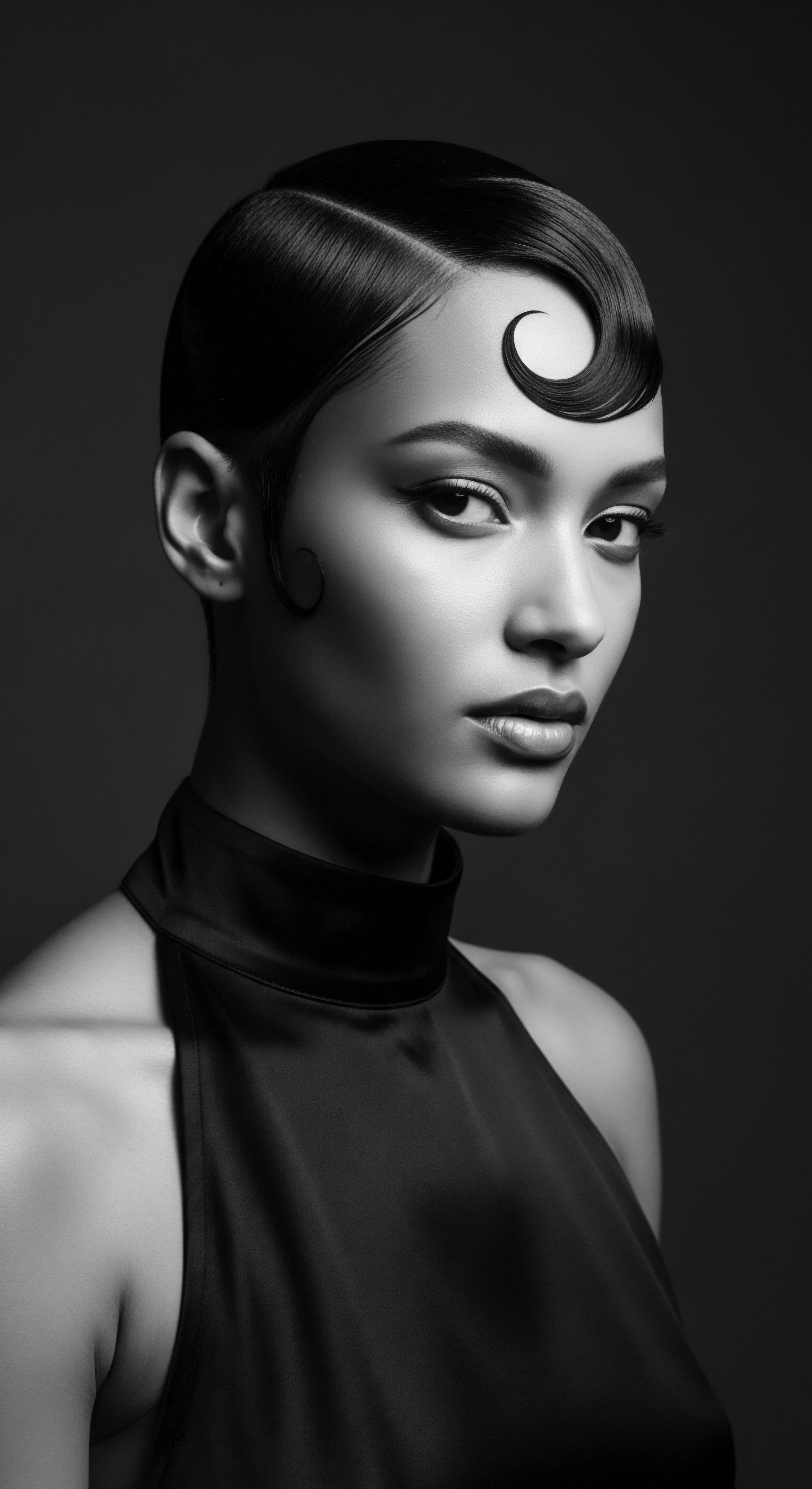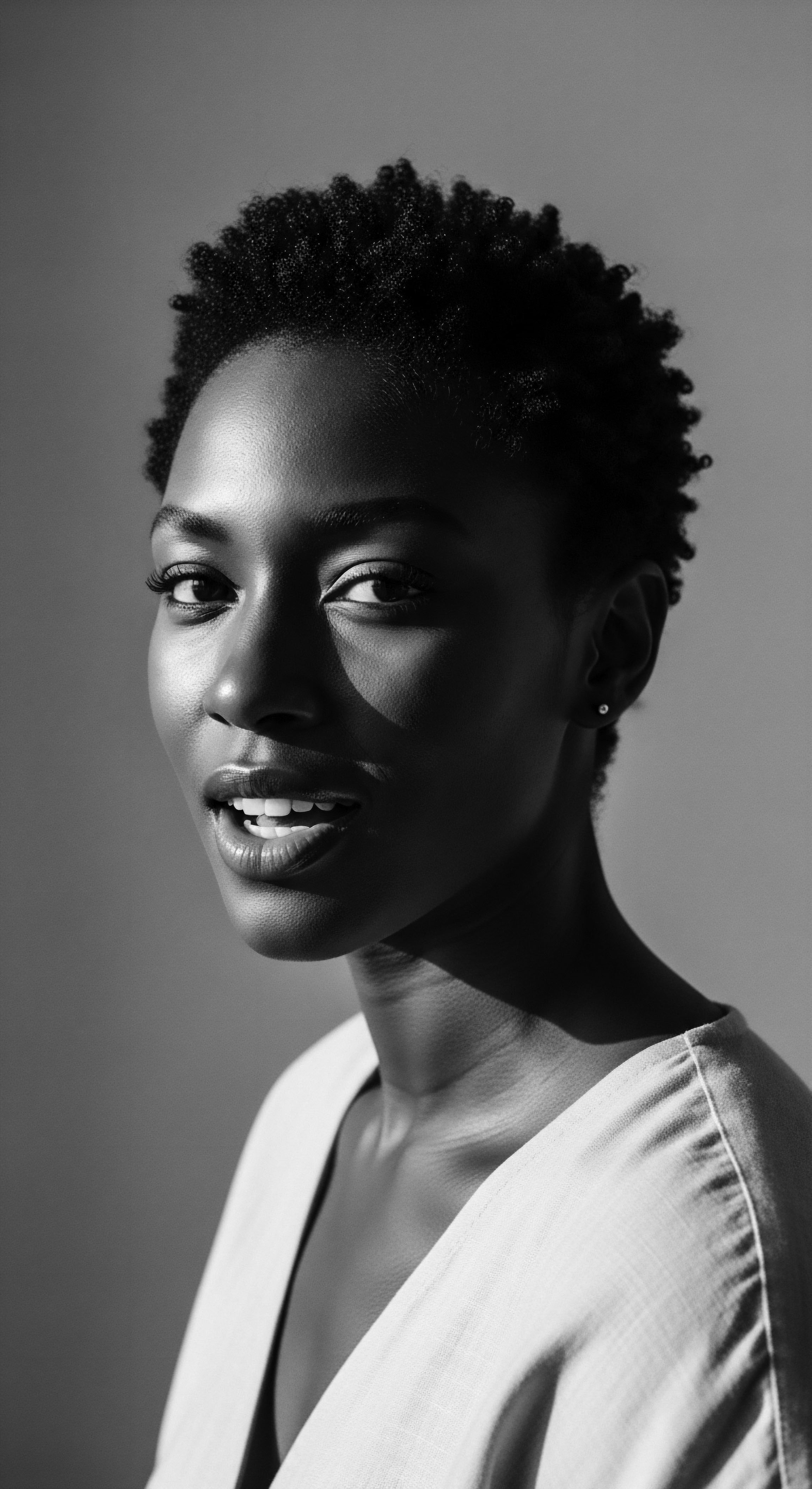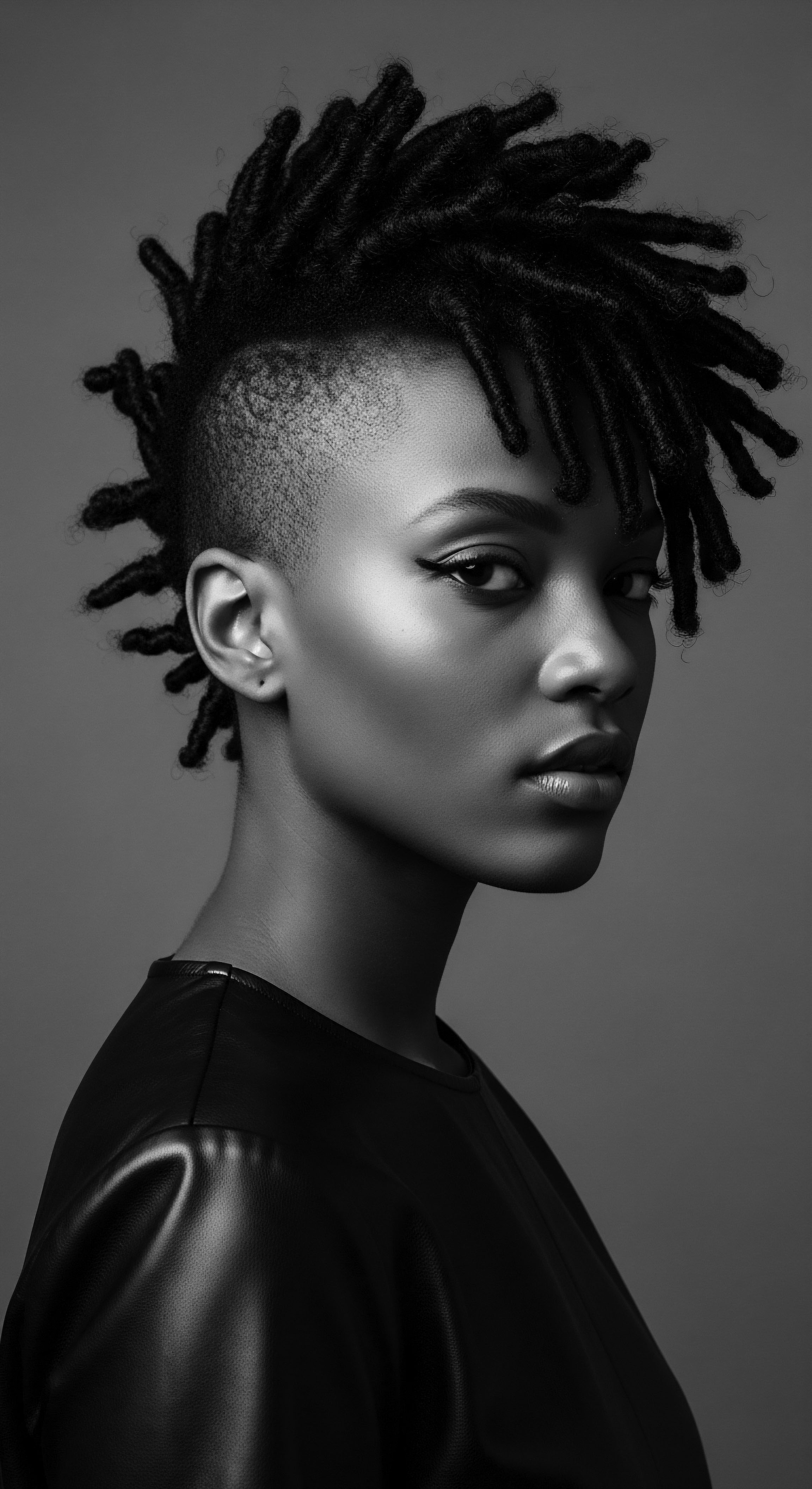
Roots
Feel the whisper of time, the gentle pull of a shared lineage that connects us to the very source of textured hair heritage. It is a story etched not just in DNA, but in the communal touch, the quiet strength found in collective rituals of care. This ancient wisdom, passed from hand to knowing hand, holds truths for every strand, every coil, every wave. It is a narrative of resilience, a testament to beauty shaped by centuries of living, tending, and celebrating.
When we ponder the communal aspects that defined historical hair care practices, particularly for textured hair, we are drawn into a profound exploration of human connection. From the earliest communal societies in Africa, hair was far more than a simple adornment. It was a living archive, a visible declaration of one’s place within the collective.
Hairstyles served as a complex language, communicating a person’s Age, Marital Status, Ethnic Identity, Religion, Wealth, and Rank within society. This intricate system of communication meant that hair care was inherently a shared undertaking, a practice deeply woven into the daily life of communities.
The anatomy of textured hair, with its unique elliptical and curved shaft, yielding more tightly curled strands, holds a delicate strength. While beautiful, these features also present points of natural weakness, demanding a specific, attentive form of care. Historically, this care was rarely a solitary pursuit. In pre-colonial African societies, the elaborate processes of washing, oiling, braiding, or twisting could require hours, even days, to complete.
Such extended periods naturally created social spaces, allowing individuals to gather, share stories, and build relationships. It was a communal activity that strengthened familial bonds, a tradition that endures even today.
The historical tending of textured hair created profound communal bonds, transforming care into shared knowledge and social interaction.
Consider the significance of hair as a spiritual conduit. Amongst the Yoruba people, for example, hair was held as the most elevated part of the human body, a direct link to the divine. Braided hair was used to send messages to the gods.
This spiritual reverence naturally transformed hair care into a sacred communal ritual, where skilled practitioners guided and shared in the shaping of spiritual connection. The precise lexicon used to describe textured hair, encompassing terms for various Curl Patterns, Textures, and States of Health, often carried cultural weight and was transmitted through generations within these communal settings.

How Does Ancestral Science Inform Our Understanding of Hair Structure?
Understanding the elemental biology of textured hair through a lens of ancestral wisdom involves recognizing how ancient peoples observed and interacted with the very physical characteristics of hair. They perhaps lacked microscopes, yet their centuries of accumulated wisdom led to practices that supported hair’s natural inclinations. They understood that hair required moisture, gentle handling, and protection, lessons that modern hair science now validates. The traditional understanding of hair’s relationship with its environment—humidity, sun, dust—informed communal care strategies that built collective resilience.

How Did Traditional Hair Classification Systems Reflect Community Values?
Traditional hair classification systems, though not formalized like modern numerical scales, were embedded in cultural observation and utility. Hairstyles often indicated a person’s Tribe or Clan, with distinct coiffures for different geographic origins. This communal recognition of hair as a marker meant that the knowledge of specific styles, their meanings, and the care required to maintain them, became a shared inheritance. The very understanding of a hair type was not solely about its physical characteristic, but about its social and cultural place within the community.
- Yoruba ❉ Elaborate styles signifying community roles, spiritual messages.
- Himba ❉ Dreadlocked styles coated with red ochre paste, symbolizing connection to earth and ancestors.
- Wolof ❉ Young girls not of marrying age partially shaved heads to show unavailability.
The hair growth cycles, though not scientifically measured in ancient times, were surely observed. The collective knowledge of how hair grows, sheds, and regenerates informed practices around trimming, protective styles, and postpartum hair care. These observations, shared orally through generations, created communal routines adapted to the natural rhythms of hair and life itself. The insights from ancestral practices demonstrate a symbiotic relationship between individuals, their hair, and the communal wisdom that sustained its health and beauty.

Ritual
The touch of hands on hair, a silent dialogue across generations, shaped the communal rituals of hair care. These were not merely acts of grooming; they were profound ceremonies of connection, the rhythms of life expressed through strand and coil. From the detailed styling techniques to the ingenious tools crafted from available materials, every aspect reflected a collective investment in appearance, identity, and shared survival.
The communal aspects defining historical hair care practices truly intensified during periods of adversity. During the transatlantic slave trade, one of the first acts of dehumanization inflicted upon enslaved Africans was the forced shaving of their heads. This act aimed to strip individuals of their African identity and sever their connection to their heritage. Yet, the resilience of the human spirit, and the enduring power of communal bonds, ensured that hair care, even under the most brutal conditions, continued as a form of resistance and cultural expression.
Braiding sessions served as vital communal spaces where stories were exchanged, solace found, and resistance quietly manifested.
Sundays, often the sole day of rest for enslaved people, transformed into a precious time for communal hair care. Here, skills were shared, lessons were taught, and the very act of tending to one another’s hair became an act of solidarity. Aunt Tildy Collins, an enslaved woman, recounted her mother and grandmother preparing her hair for Sunday school, using a “jimcrow” comb before threading or plaiting her hair to achieve defined curls. This practice, born of necessity and shared struggle, became a deeply rooted communal tradition.
The artistry of protective styling, so deeply intertwined with textured hair heritage, finds its origins in these communal spaces. Styles like Cornrows, Braids, and Locs, which offer protection to the hair shaft from environmental elements and manipulation, were not only aesthetically significant but also functionally vital. In many pre-colonial African societies, these styles were created with profound intention and often took many hours, fostering sustained social interaction.

What Hidden Messages Did Hairstyles Carry During Enslavement?
Perhaps one of the most astonishing examples of communal hair care as a tool of survival and resistance lies in the ingenious use of cornrows during enslavement. Enslaved Black people in America are thought to have woven specific patterns into their hair to encode information about escape routes, safe houses, and other resources. One common pattern was the “North Star” pattern, a series of three cornrows braided in a straight line from the forehead to the nape of the neck, indicating that the escape route led north toward free states. Other patterns conveyed instructions for river crossings or mountainous terrain.
This secret language, passed down through whispers and skilled hands, highlights the profound communal ingenuity and the inherent trust placed in the shared act of hair styling. The very patterns of braided hair became maps of hope and freedom.
| Historical Period Pre-Colonial Africa |
| Communal Hair Practice Group braiding sessions |
| Significance or Hidden Meaning Conveying social status, marital standing, tribal identity, or spiritual beliefs. |
| Historical Period Enslavement Era |
| Communal Hair Practice Secret cornrow patterns |
| Significance or Hidden Meaning Mapping escape routes, indicating safe houses, or signaling allies on the path to freedom. |
| Historical Period Hair practices, both overt and covert, consistently served as powerful communal expressions of heritage and resilience. |
The tools themselves, too, bore the mark of communal resourcefulness. In times of scarcity, enslaved people adapted, creating combs and picks from salvaged wood, bone, or metal. These simple, hand-fashioned implements were likely shared amongst families and communities, each tool carrying the history of its use and the many hands it passed through.
Natural oils, such as Shea Butter and Coconut Oil, along with animal fats, were used to moisturize and protect hair from harsh conditions. These ingredients, often sourced and prepared communally, became essential components of shared care.
Even the headwrap, a seemingly simple accessory, took on significant communal meaning. In 1786, New Orleans introduced the Tignon Laws, forcing Creole women of color to cover their hair with headscarves, or “tignons,” to signify their perceived lower social standing. In a striking act of collective rebellion, these women transformed the symbol of oppression into an expression of beauty and defiance, adorning their tignons with beautiful, colorful fabrics and jewels. This communal act of reappropriation turned a mandated covering into a symbol of resilience and cultural pride, a powerful visual statement understood within their community.

Relay
The echoes of ancestral wisdom reverberate through contemporary hair care, a continuous relay of knowledge that connects ancient traditions to modern practice. The communal aspects that once defined historical hair care have transformed, yet their spirit persists, now manifesting in new forms of collective support and shared discovery for textured hair.
The holistic approach to hair care, a concept deeply rooted in ancestral philosophies, acknowledged the interconnectedness of physical, spiritual, and communal well-being. Historically, hair health was not separated from the health of the individual or the community. Nourishing the scalp, strengthening strands, and maintaining styles were seen as integral parts of a larger system of personal and collective vitality.
Modern wellness advocates for textured hair draw directly from this lineage, advocating for practices that honor the hair’s natural state and its connection to overall health. Brands like Sienna Naturals, for example, build their “Rooted Technology” by blending ancestral wisdom with clean, modern technology, emphasizing scalp health and the use of natural ingredients like Blue Tansy and Baobab Oil.
The enduring legacy of communal hair care is reflected in contemporary movements that celebrate textured hair as a shared identity.

How Do Contemporary Hair Care Regimens Reflect Ancestral Practices?
Modern textured hair care regimens, often highly personalized, still bear the imprint of historical communal practices. The emphasis on gentle cleansing, deep conditioning, and protective styling can be seen as a direct continuation of ancestral methods that prioritized hair preservation. Early African shampoos, often multi-purpose bars, and homemade leave-on products of oils, butters, and resins were used for growth, strength, and curl enhancement. These practices, once shared and refined within communities, now inform many contemporary routines.
Problem-solving for textured hair, too, finds its roots in communal knowledge. Issues like dryness, breakage, or tangling were not individual burdens but collective challenges addressed through shared remedies and learned techniques. The development of specific tools, like the afro pick, rediscovered in the 1960s, marked a return to ancient hair care tools and coincided with a resurgence of Black self-esteem and the “Black is Beautiful” movement. These advancements are not isolated scientific breakthroughs but a continuous evolution, often validating the efficacy of what was already understood through ancestral experience.
- Black Castor Bean Oil ❉ Used traditionally for moisturizing hair and soothing the scalp, now a staple in many textured hair products.
- Avocado Oil ❉ Recognized for its rich fatty-acid composition, nourishing hair and conditioning.
- Plantain Extract ❉ Valued for potassium and antioxidants, nurturing and protecting hair.
The concept of the “nighttime sanctuary” for hair care, with the common use of Bonnets, Scarves, and Satin Pillowcases, holds a deep ancestral basis. Historically, covering hair protected intricate styles, preserved moisture, and signified marital status or mourning. This practice extends the communal care into a personal nightly ritual, protecting the hair and maintaining its condition, a direct descendant of generations who understood the need for consistent care, even through sleep.

How Did Hair Salons Become Communal Hubs After Emancipation?
Following emancipation, as Black communities rebuilt and navigated new social landscapes, beauty salons and barbershops emerged as vital communal spaces. These establishments were not just places for hair styling; they became centers of social and economic life. Within these walls, community members could discuss issues facing them, share stories, find support, and reinforce collective identity.
Even as individuals moved to new areas, many retained ties to their established community hair care providers, underscoring the enduring importance of these communal hubs. The enduring legacy of these spaces speaks volumes to the communal need for shared spaces of care and cultural exchange.
The concept of “braiding circles” continues this communal legacy today. Projects like those by artist Veronica Perez directly draw inspiration from the longstanding oral storytelling traditions in Black, Latinx, and Indigenous cultures. These contemporary braiding circles aim to preserve history, combat feelings of isolation, and create spaces where individuals can feel a strong sense of belonging.
Through the shared act of braiding, participants explore identity and history, their collective voices shaping a living narrative. This tangible connection between the hands-on care of hair and the cultivation of community remains a powerful thread in the heritage of textured hair.

Reflection
The journey through the communal aspects of historical hair care, particularly within textured hair heritage, reveals a profound truth ❉ hair has always been a living, breathing archive of identity, resilience, and community. From the spiritual reverence held in pre-colonial African societies, where braided patterns spoke volumes about lineage and status, to the ingenious ways enslaved communities used hair to map pathways to freedom, the thread of collective care runs unbroken. Each strand tells a story, not just of individual journeys, but of shared wisdom, enduring strength, and an unbreakable spirit.
The legacy of communal hair practices reminds us that caring for our coils and curls extends beyond the physical; it is an act of honoring our ancestral inheritance, a continuous act of connection to those who came before and those who walk beside us now. This collective memory, preserved in the rituals we perform and the stories we share, ensures that the soul of a strand, indeed, continues to live on.

References
- Byrd, Ayana and Tharps, Lori L. (2001). Hair Story ❉ Untangling the Roots of Black Hair in America. St. Martin’s Press.
- Carney, Judith A. (2001). “With Grains in Her Hair” ❉ Rice in Colonial Brazil. UCLA Geography.
- Collins, “Aunt Tildy” (1975). Born in Slavery ❉ Slave Narratives from the Federal Writers’ Project. Library of Congress.
- Duggan, Michelle M. (2025). Historical Perspectives on Hair Care and Common Styling Practices in Black Women. Journal of the National Medical Association.
- Ibonye, Theresa and Okwudi, Victoria. (2025). History, identity, and community ❉ The significance of Black hair. The Queen’s Journal.
- Ojo, Uche. (2023). What Every Dermatologist Must Know About the History of Black Hair. Journal of Drugs in Dermatology.
- Perez, Veronica. (2024). Braiding Circles. Taller Puertorriqueño.
- Unknown. (2024). African Hairstyles ❉ Cultural Significance and Legacy. Afriklens.
- Unknown. (2024). The Cultural Significance Of Natural Hair In Different Communities. The Kurl Kitchen.
- Unknown. (2023). ROAD TO FREEDOM ❉ How Enslaved Africans in America Used Hair Styles to Map Escape Routes. Childish Mane LLC.
- Unknown. (2022). The history of Black Hair. BLAM UK CIC.
- Unknown. (2021). Hair Care Is a Focus in Africa. Happi.
- Unknown. (2023). Pre-Colonial African Hairstyles. AfrikaIsWoke.com.
- Unknown. (2024). The Remarkable History Behind Black Hairstyles. University of Salford Students’ Union.
